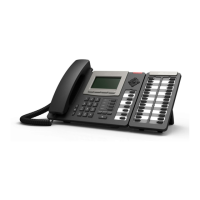
Do you have a question about the Yealink T26 and is the answer not in the manual?
| Network Ports | 2x RJ45 10/100M Ethernet ports |
|---|---|
| Supported Protocols | SIP (RFC3261), TLS, SRTP |
| Audio Codecs | G.711, G.722, G.729 |
| HD Voice | Yes |
| Power Supply | IEEE 802.3af PoE or 5V DC adapter |
| Operating Temperature | 0°C to 40°C (32°F to 104°F) |
| Humidity | 10 ~ 95% |
Lists the items included in the T26 VoIP Phone package.
Details on connecting the phone to the network and power.
Covers essential setup steps and network configuration for the phone.
Explains how to initiate calls using different methods and devices.
Provides instructions on how to receive incoming calls and manage conversations.
Describes how to enable and disable Do Not Disturb mode.
Details the process for forwarding incoming calls to another number.
Explains how to place active calls on hold and retrieve them.
Covers enabling and managing the call waiting feature.
Instructions for muting and unmuting the microphone during a call.
Explains different methods for transferring calls to other parties.
Guides on how to set up and manage three-way conference calls.
Details the phone's capability to manage multiple SIP accounts and lines.
Explains how to pick up calls for other extensions using a prefix.
Details how to join an existing call by inputting a prefix and number.
Covers redialing the last number and canceling redial attempts.
Describes initiating calls by clicking links on web pages.
Explains how to redial the last received call.
Covers setting up the phone to automatically answer incoming calls.
Details configuring a hotline number for automatic outgoing calls.
Provides access to phone applications like SMS, Memo, Voice Mail, and Ping.
Explains automatic call ending based on configured time.
Covers blocking incoming calls from anonymous callers.
Details how to disable outgoing calls.
Covers configuring rules for call dialing based on number patterns.
Explains setting up specific rules for routing calls based on destination.
Details automatic redialing of busy or rejected calls.
Covers features that notify or redial when a busy line becomes available.
Enables incoming call rings to be heard through the headset.
Covers enabling or disabling the power indicator light.
Explains how to hide DTMF signals during calls.
Details setting up a password for making calls.
Covers pre-dialing functionality.
Explains using URLs to trigger phone actions or report events.
Describes pushing XML data to the phone for updates or actions.
Covers configuration options for the phone's keyboard and keys.
Details adjusting screen settings like contrast and brightness.
Explains how to set the ringer volume and select ringtones.
Covers adjusting the phone's voice volume levels.
Details setting the phone's time and date, manually or automatically.
Allows setting a custom message displayed on the phone screen at startup.
Covers selecting the phone's display language.
Covers SIP account configuration and settings.
Details network configuration options for the phone.
Explains security settings like password and keylock.
Covers maintenance tasks like auto-provisioning and upgrades.
Details how to reset the phone to its factory default settings.
Overview of methods for configuring the T26 phone.
Explains the different user levels and default login credentials.
Guides on accessing and configuring the phone through a web interface.
Step-by-step guide for network setup and configuration.
Covers querying and viewing outgoing call records.
Allows selection of the phone's display language and greeting message.
Covers network configuration settings for the phone.
Details Wide Area Network (WAN) settings, including IP and connection modes.
Explains Local Area Network (LAN) configuration options.
Covers Quality of Service and VLAN settings for network traffic management.
Allows configuration of ports for services like telnet and HTTP.
Details DHCP server settings and IP address management.
Covers setting time zones, SNTP, and daylight saving time.
Detailed configuration for SIP accounts, codecs, and advanced SIP settings.
Covers configuration settings for IAX2 accounts.
Details settings for STUN traversal to enable SIP penetration through NAT.
Covers creating flexible dialing rules and call routing.
Details phone-specific settings.
Covers audio settings, codecs, and voice processing configurations.
Defines actions to be triggered by specific URLs.
Allows configuration of blocked outgoing numbers.
Covers fundamental dial plan settings like # to send and fixed length.
Details the user-defined digital map rules for call dialing.
Displays and manages the phone's contact list.
Instructions for adding new contacts to the phonebook.
Covers managing contact groups.
Details importing contact files into the phonebook.
Explains exporting contact files from the phone.
Allows configuration of numbers to block or allow.
Covers accessing and configuring remote phonebook entries.
Enables making calls directly through the web interface.
Covers settings related to screen display and backlight.
Details configuration of the phone's line keys.
Explains how to assign functions to programmable keys.
Details the mapping of keys to various functions.
Covers configuration for external expansion modules.
Allows customization of softkey functions for different screens.
Covers automatic phone configuration and firmware updates.
Details system log management settings.
Covers saving, backing up, and clearing phone configurations.
Explains how to update phone configuration files and firmware.
Covers user account management and access permissions.
Details how to set up user accounts and their privileges.
Covers filtering web access based on IP addresses.
Details firewall rules for network security.
Explains Net Address Translation settings.
Covers configuring a Demilitarized Zone for network security.
Details application layer gateway and NAT table settings.
Covers virtual private network setup.
Details L2TP and OpenVPN configuration for secure connections.
Covers managing security files like TLS and OpenVPN certificates.
Explains how to log out of the web interface.
Provides technical specifications for the phone's hardware and features.
Details the voice capabilities and supported codecs of the phone.
Outlines the phone's network support, including VLAN, NAT, and VPN.
Shows the mapping between keypad characters and their functions.